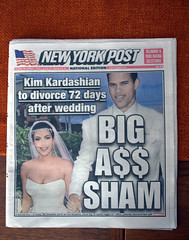
The most recent marital meltdown making headlines involves the rapid “I don’t” of entrepreneur Kim Kardashian and pro basketball player Kris Humphries. While their split’s every detail is dissected everywhere from tabloids to 24 hour news networks, the Des Moines Resister took a different angle on the issue: they talked to some sociologists.
Susan Stewart, associate professor of sociology at Iowa State University, and Tony Paik, associate professor the University of Iowa’s Department of Sociology, helped explain some of the broader societal issues affecting early divorce and how we perceive flame-out marriages. Stewart maintains that although people generally don’t talk about their own divorces, it’s fair game to critique others’. This appears to especially be true for the nearly 1 in 4 U.S. marriages that end within the first 5 years.
“We are fascinated when people crash and burn,” Stewart said. “It’s a way to work through [our own issues]: ‘They are way worse off than I am.’ ”
Stewart believes age is often a determining factor in early divorce, but short engagement periods and contrasting religious or family backgrounds also come into play. And Paik presents data showing that earlier intercourse, surprisingly, may also be a determinant of short-lived marriages: according to Paik’s analysis, of those who remain abstinent until age 18, only 15 percent will divorce within the first 5 years of marriage. Those who have sex before 18 are shown to divorce at at rate of 31 percent.
Paik hasn’t determined why this might be, but he speculates that sex at a young age may lead to other possible divorce determinants, including premarital pregnancy, permissiveness toward non-marital sex, and premarital cohabitation–each of which seems to lose relevance over time, particularly when it comes to the Kardashian-Humphries union, which, so far as the prurient public knows, included none of these factors.







